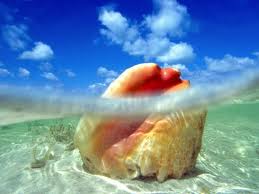 High on top of the Bahamian crest is a queen conch—an iconic representation of how truly integrated marine ecosystems are to Caribbean culture. Queen conch (Strombus gigas) is a large gastropod native to the Caribbean and has been a staple in the Bahamian diet for centuries. Unfortunately, the overfishing of conch has caused massive declines in populations, and conservation efforts are greatly needed to promote a healthy and sustainable conch fishery in the Bahamas.
High on top of the Bahamian crest is a queen conch—an iconic representation of how truly integrated marine ecosystems are to Caribbean culture. Queen conch (Strombus gigas) is a large gastropod native to the Caribbean and has been a staple in the Bahamian diet for centuries. Unfortunately, the overfishing of conch has caused massive declines in populations, and conservation efforts are greatly needed to promote a healthy and sustainable conch fishery in the Bahamas.
In fisherman lore around the Bahamas it is said to be bad luck to throw knocked conch into the water, as it will scare away living conch—thus, huge conch middens are often found onshore. But, some conch are still tossed overboard at sea, and it is thought this may also be affecting conch populations. The Sustainable Fisheries team, here at the Cape Eleuthera Institute (CEI), is testing avoidance behavior from conch with help of several Island School students. The main question is- do conch flee upon seeing/smelling an injured or dead conspecific, and if so, what sort of cue is triggering movement?
So far 40 trials have been conducted, and CEI’s Claire Thomas, Program Manager for Sustainable Fisheries, will be presenting the preliminary results at the Bahamas National Trust Natural History Conference in Nassau this week. As we conduct more trials and gain more insight into potential conch avoidance behavior, there may be implications for new management strategies to better protect this important species—stay tuned for results!

